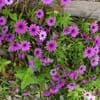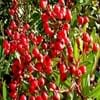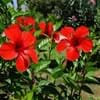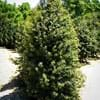Life Span
Perennial
Perennial
Origin
Hybrid origin, South Africa
Southeastern Asia, Melanesia, Micronesia
Types
Not Available
Jackfruit, Breadnut, Figs
Habitat
gardens
Lowland evergreen rainforest, Riverine swamp forest
USDA Hardiness Zone
10-11
10-15
Sunset Zone
8, 9, 12, 13, 14, 15, 16, 17, 18, 19, 20, 21, 22, 23, 24
H2
Habit
Clump-Forming
Oval or Rounded
Flower Color
Light Purple, Purple
Yellow green
Flower Color Modifier
Bicolor
Bicolor
Fruit Color
Not Available
Yellow, Green, Yellow green, Brown
Leaf Color in Spring
Green, Blue Green
Dark Green
Leaf Color in Summer
Green, Blue Green
Dark Green
Leaf Color in Fall
Green, Blue Green
Dark Green
Leaf Color in Winter
Gray Green, Silver
Light Green
Leaf Shape
Elliptic, toothed
Irregular
Plant Season
Spring, Summer, Fall
Spring, Summer, Fall, Winter
Sunlight
Full Sun
Full Sun, Partial Sun
Type of Soil
Loam
Loam, Sand
The pH of Soil
Neutral
Acidic, Neutral, Alkaline
Soil Drainage
Well drained
Average
Bloom Time
Late Spring, Early Summer, Summer, Late Summer, Early Fall, Fall
Indeterminate
Tolerances
Drought, Salt
Drought
Where to Plant?
Container, Ground, Pot
Ground
How to Plant?
Cuttings, Seedlings
Grafting, Rooted stem cutting, Seedlings
Plant Maintenance
Medium
Medium
Watering Requirements
Requires regular watering
Average Water Needs, Never Over-water, occasional watering once established, Water daily during growing season, Water Deeply
In Summer
Lots of watering
Lots of watering
In Spring
Moderate
Moderate
In Winter
Average Water
Average Water
Soil pH
Neutral
Acidic, Neutral, Alkaline
Soil Type
Loam
Loam, Sand
Soil Drainage Capacity
Well drained
Average
Sun Exposure
Full Sun
Full Sun, Partial Sun
Pruning
Remove damaged leaves, Remove dead branches, Remove dead leaves
Prune every year, Prune if you want to improve plant shape, Remove branches, Remove damaged leaves, Remove dead branches, Remove dead leaves, Remove dead or diseased plant parts
Fertilizers
All-Purpose Liquid Fertilizer
20-20-20 amount, All-Purpose Liquid Fertilizer
Pests and Diseases
Aphids, Caterpillars, Root rot, Spider mites, Stem rot, Whiteflies
Red blotch
Plant Tolerance
Drought
Drought
Flower Petal Number
Single
Not Available
Foliage Texture
Medium
Coarse
Foliage Sheen
Glossy
Glossy
Attracts
Bees, Butterflies, Insects
Birds, Not Available
Allergy
Not Available
allergic reaction
Aesthetic Uses
Showy Purposes
Not Used For Aesthetic Purpose
Beauty Benefits
Not Available
Good for skin, Promotes Healthy Hair, Removes dandruff, Speed hair growth
Environmental Uses
Air purification
Air purification, Nesting sites for birds, Shadow Tree, Wildlife
Medicinal Uses
Not Available
Cancer, cholesterol-lowering, Heart problems, High cholestrol, Immunity, Skin Disorders, Weight loss
Part of Plant Used
Flowers
Fruits
Other Uses
Air freshner, Oil is used in perfume, soaps, creams, etc., useful as a ground cover
Used As Food, Used for its medicinal properties
Used As Indoor Plant
Yes
No
Used As Outdoor Plant
Yes
Yes
Garden Design
Bedding Plant, Container, Cutflower, Groundcover, Hanging Basket, Mixed Border, Rock Garden, Wall
Edible, Feature Plant, Fruit / Fruit Tree, Shade Trees, Tropical
Botanical Name
OSTEOSPERMUM 'Aksullo'
ARTOCARPUS altilis
Common Name
African daisy, Blue-eyed daisy
Breadfruit
In Hindi
Cape Daisy
Breadfruit Tree
In German
Cape Daisy
Brotfruchtbaum
In French
Cape Daisy
Breadfruit Arbre
In Spanish
Margarita del Cabo
árbol del pan
In Greek
Cape Daisy
αρτόδεντρο Δέντρο
In Portuguese
Cape Daisy
Árvore de fruta-pão
In Polish
Cape Daisy
Breadfruit drzewo
Phylum
Magnoliophyta
Magnoliophyta
Class
Magnoliopsida
Magnoliopsida
Order
Asterales
Urticales
Family
Asteraceae
Moraceae
Genus
Osteospermum
Artocarpus
Clade
Angiosperms, Asterids, Eudicots
Angiosperms, Eudicots, Rosids
Tribe
Calenduleae
Artocarpeae
Subfamily
Asteroideae
Not Available
Season and Care of Cape Daisy and Breadfruit
Season and care of Cape Daisy and Breadfruit is important to know. While considering everything about Cape Daisy and Breadfruit Care, growing season is an essential factor. Cape Daisy season is Spring, Summer and Fall and Breadfruit season is Spring, Summer and Fall. The type of soil for Cape Daisy is Loam and for Breadfruit is Loam, Sand while the PH of soil for Cape Daisy is Neutral and for Breadfruit is Acidic, Neutral, Alkaline.
Cape Daisy and Breadfruit Physical Information
Cape Daisy and Breadfruit physical information is very important for comparison. Cape Daisy height is 20.30 cm and width 20.30 cm whereas Breadfruit height is 2,600.00 cm and width 600.00 cm. The color specification of Cape Daisy and Breadfruit are as follows:
Cape Daisy flower color: Light Purple and Purple
Cape Daisy leaf color: Green and Blue Green
Breadfruit flower color: Yellow green
- Breadfruit leaf color: Dark Green
Care of Cape Daisy and Breadfruit
Care of Cape Daisy and Breadfruit include pruning, fertilizers, watering etc. Cape Daisy pruning is done Remove damaged leaves, Remove dead branches and Remove dead leaves and Breadfruit pruning is done Prune every year, Prune if you want to improve plant shape, Remove branches, Remove damaged leaves, Remove dead branches, Remove dead leaves and Remove dead or diseased plant parts. In summer Cape Daisy needs Lots of watering and in winter, it needs Average Water. Whereas, in summer Breadfruit needs Lots of watering and in winter, it needs Average Water.





